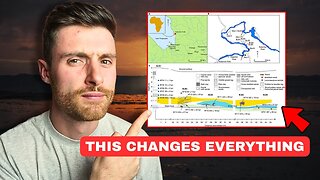Premium Only Content

The Fractal Mind: Mapping the Infinite Potential of Consciousness
Introduction: The Infinite Game of the Mind
Imagine standing at the edge of a vast, intricate labyrinth. Each turn reveals not walls, but mirrors—reflecting infinite possibilities. This is your mind: a fractal structure where every thought, every insight, is a smaller part of an ever-expanding whole. To truly expand your consciousness is to become both the explorer and the architect of this labyrinth.
Consciousness, in its essence, is infinite. But to access its full potential, you must learn to think beyond linearity, beyond binaries, beyond the frameworks imposed by society and self. This journey isn’t simply about knowledge; it’s about transforming how you perceive, integrate, and create from the fabric of existence.
Section 1: The Fractal Nature of Reality and Mind
1.1. The Fractal Universe
• A fractal is a pattern that repeats itself across scales, from the microscopic to the cosmic. Think of a fern leaf: each smaller segment mirrors the larger structure.
• Physicist Nassim Haramein and others suggest that the universe itself operates fractally, from the structure of galaxies to the arrangement of atoms.
1.2. The Mind as a Fractal
• Your consciousness mirrors this structure. Every idea contains the seed of another, infinitely branching.
• Carl Jung’s concept of the collective unconscious can be viewed as a fractal—a shared pool of archetypes that manifest differently in individual psyches.
1.3. Why Fractals Matter
• Fractals demonstrate that complexity arises from simplicity. By understanding and embracing this principle, you can learn to generate infinite creative insights from basic patterns.
Section 2: Unlocking Fractal Thinking
2.1. The Art of Pattern Recognition
• Train your mind to see connections where others see chaos. Start by observing recurring themes in your life, from dreams to conversations.
• Exercise: Keep a “pattern journal” where you note symbols, words, or ideas that recur in your daily experience.
2.2. The Power of Iteration
• Like a fractal, your thoughts can evolve through iteration—refining and expanding upon an initial idea.
• Technique: Take a simple question (e.g., “What is time?”) and expand it by asking a new question after each answer. Push yourself to iterate until you reach a profound insight.
2.3. Breaking Dimensional Constraints
• Fractals can exist in fractional dimensions, blurring boundaries. Apply this to your thinking by blending disciplines or exploring paradoxes.
• Example: Combine the logic of mathematics with the fluidity of poetry to solve a problem creatively.
Section 3: Tools for Expanding Consciousness
3.1. Meditative Fractal Visualization
• Enter a meditative state and visualize a fractal. Imagine diving deeper into its layers, allowing each iteration to reveal something new about your inner self.
• Practical Tip: Use Mandelbrot set visualizations or nature-inspired fractals as a focus during meditation.
3.2. Neural Fractals: Embracing Neuroplasticity
• Your brain’s neural networks are fractal-like, capable of rewiring and creating new connections through practice and intention.
• Actionable Step: Challenge your brain with novel tasks (e.g., learning a new language or solving abstract puzzles) to foster growth.
3.3. Altering Perception Through Art
• Fractal art and music (like Bach’s compositions or visual works inspired by fractals) can alter your brainwaves, leading to enhanced creativity and insight.
Section 4: The Philosophical Implications of Fractals
4.1. As Above, So Below
• The Hermetic axiom suggests that the micro mirrors the macro—a concept central to fractal theory. What you explore within yourself mirrors the universe’s structure.
• Reflection Exercise: Examine how your personal struggles reflect larger societal issues or universal archetypes.
4.2. The Feedback Loop of Reality
• Consciousness and reality are inextricably linked, forming a feedback loop where observation shapes existence.
• Application: Practice “active observation” by consciously choosing how you interpret events, and watch how this alters outcomes.
4.3. Embracing the Infinite Game
• Philosopher James P. Carse describes two types of games: finite (with winners and losers) and infinite (played for the purpose of continuing). Expanding consciousness means engaging life as an infinite game—one of endless discovery and creation.
Section 5: Practical Integration
5.1. Hybrid Daily Practice
Combine techniques to engage different facets of your mind:
• Morning: Fractal Meditation (visualize infinite branching patterns).
• Afternoon: Pattern Journaling (connect dots between your observations and inner insights).
• Evening: Neural Challenge (solve a problem creatively or try an unfamiliar task).
5.2. Collaborative Exploration
• Share your ideas with others to create a fractal network of shared consciousness. Each perspective enhances the whole.
5.3. Micro-to-Macro Mindset
• Approach daily tasks with the awareness that even the smallest actions reflect universal principles. This mindset cultivates depth in every experience.
Conclusion: The Infinite Self
To map the infinite potential of your consciousness is to realize that the map itself is fractal, ever-expanding as you grow. By embracing the fractal nature of reality, you unlock the ability to think differently, create uniquely, and innovate endlessly. Every step into this labyrinth is both an exploration and a return to the self.
This journey is not about arriving at an endpoint but about continuously expanding—mirroring the fractals that define existence itself. In every thought, every action, the infinite awaits.
The Fractal Mind: Part Two – Unlocking Multidimensional Consciousness
Introduction: Beyond the Edge of Thought
In Part One, we explored the fractal nature of consciousness and its potential for infinite growth. Now, we move beyond understanding and into activation. To truly expand consciousness, you must go beyond intellectual comprehension and engage multidimensional aspects of your being—emotional, physical, intuitive, and collective. This journey requires a hybridized approach that integrates techniques from science, metaphysics, and the deeply experiential.
In this second installment, we delve into deeper realms of consciousness, harnessing tools and frameworks that amplify your ability to think, feel, and create in profoundly unique ways.
Section 1: The Multidimensional Framework of Consciousness
1.1. The Dimensions of Being
To operate on a multidimensional level, recognize that consciousness is not one-dimensional. The following framework helps you map your awareness:
1. Physical Consciousness: Rooted in your sensory and bodily experience. It’s how you perceive the tangible world.
2. Emotional Consciousness: Governs feelings and the energy of connection.
3. Mental Consciousness: The realm of thoughts, logic, and ideas.
4. Intuitive Consciousness: The non-linear knowing that often arises without logical explanation.
5. Collective Consciousness: The shared web of thoughts, archetypes, and energy across humanity.
6. Cosmic Consciousness: Awareness that transcends individuality, connecting with universal intelligence.
1.2. Fractals in Multidimensional Awareness
• Each dimension operates fractally, reflecting patterns across scales.
• Example: A personal emotion like fear may mirror collective anxiety within society. Understanding this connection allows for deeper insight into both personal and global transformation.
1.3. Harnessing Dimensional Synergy
• True innovation and insight emerge when these dimensions work in synergy. For example:
• Physical: Engaging the body through movement (e.g., yoga) sparks new ideas.
• Mental + Intuitive: Combining analytical reasoning with gut instincts leads to breakthroughs.
• Collective: Collaborating with others amplifies the fractal web of creativity.
Section 2: Techniques for Expanding Multidimensional Consciousness
2.1. The Triune Practice
This daily practice combines three core elements to engage multiple dimensions:
• A. Physical: Begin with a grounding activity like walking barefoot, breathwork, or a body scan meditation.
• B. Emotional: Journal or reflect on emotional patterns you’ve noticed throughout the day, tracing their origins and impact.
• C. Mental/Intuitive: End with a creative exercise, such as drawing your thoughts or meditating on a paradox (e.g., “What does infinity feel like?”).
2.2. Intuition Amplifier: Tapping Into the Non-Linear Mind
1. Choose a problem or question.
2. Sit quietly, allowing your mind to settle (use rhythmic breathing or soft music).
3. Visualize your question dissolving into light and reforming as a symbol (e.g., a tree, a labyrinth).
4. Reflect on this symbol and note the first ideas or emotions that arise. These are intuitive signals—your non-linear mind’s attempt to communicate.
2.3. Holographic Vision: Seeing the Whole Within the Part
• Choose a simple object (e.g., a leaf or a cup).
• Study it in detail for five minutes, observing every curve, texture, and imperfection.
• Expand your awareness, imagining how this single object connects to the larger systems it belongs to (the tree, the forest, the earth).
• Reflect on how this exercise mirrors your own role in the fractal web of existence.
Section 3: The Role of Archetypes in Consciousness Expansion
3.1. Archetypes as Fractal Patterns
• Archetypes—universal symbols like the Hero, the Creator, or the Shadow—are fractal patterns that manifest across cultures and individuals.
• Understanding your personal archetypal patterns can provide a roadmap for personal growth and transformation.
3.2. Identifying Your Dominant Archetype
1. Reflect on stories or myths that resonate deeply with you (e.g., heroes, rebels, visionaries).
2. Analyze recurring dreams or symbols in your life.
3. Identify how these archetypes influence your decisions, challenges, and aspirations.
3.3. Activating Archetypes
• Once identified, you can invoke archetypes to guide your actions:
• Hero: Pushes you to overcome adversity.
• Creator: Inspires innovation and artistic expression.
• Sage: Guides wisdom and discernment.
Section 4: Practical Applications of Fractal Consciousness
4.1. Problem-Solving Through Fractal Thinking
1. Deconstruct a problem into its smallest components. For example, if the problem is “stress,” break it into:
• Physical (tight muscles, disrupted sleep)
• Emotional (anxiety, overwhelm)
• Mental (negative thought loops)
2. Address each component fractally—find small solutions that ripple outward (e.g., practicing breathwork reduces physical tension, calming emotions, and clearing thoughts).
4.2. Using Collective Intelligence
• Engage with communities or groups to solve complex problems. Just as fractals expand through replication, ideas grow exponentially through shared input.
• Exercise: Host a brainstorming session where every participant builds on the previous person’s idea. This models fractal growth in real time.
4.3. Creative Flow as a Fractal State
• Creativity is inherently fractal—each idea leads to another in an ever-expanding web.
• Enter a “flow state” by:
• Setting clear goals.
• Removing distractions.
• Balancing challenge and skill (tasks should be engaging but not overwhelming).
Section 5: Consciousness as a Catalyst for Innovation
5.1. Redefining Time and Space
• The human mind is capable of transcending linear time. Practices like visualization and remote viewing demonstrate how consciousness can “travel.”
• Practical Exercise: Before bed, visualize your future self achieving a specific goal. Ask yourself, “What wisdom do I need to reach this point?” Write down the insights that emerge.
5.2. The Infinite Workspace
• Treat your consciousness as a workspace where ideas, emotions, and insights coexist. By organizing this space intentionally, you amplify your creative output.
• Technique: Visualize your mind as a room or landscape. Populate it with symbols (e.g., a fountain for intuition, a mountain for challenges) to structure your thinking.
5.3. Fractal Leadership
• Whether guiding yourself or others, fractal leadership means creating structures that adapt and expand. Focus on principles (not rigid rules) that ripple outward:
• Encourage creativity and autonomy.
• Solve problems at the root to create systemic change.
Section 6: The Paradox of Infinite Consciousness
6.1. Balancing the Micro and the Macro
• Expanding consciousness requires balance—focusing simultaneously on the smallest details (e.g., a breath) and the vast whole (e.g., the universe’s energy flow).
• This dual awareness strengthens your ability to navigate complexity.
6.2. Embracing the Mystery
• True expansion doesn’t mean solving every mystery but learning to live harmoniously with uncertainty. The unknown is the fertile ground for infinite potential.
• Reflection Question: “What can I learn from the parts of myself or the universe that I don’t yet understand?”
6.3. Becoming the Fractal Explorer
• The more you explore consciousness, the more you realize it is not a destination but a constantly shifting horizon. The key is to embrace the process of discovery itself as the ultimate goal.
Conclusion: Building the Fractal Bridge
Consciousness is the bridge between the known and the infinite. By engaging its multidimensional nature and embracing fractal thinking, you can unlock profound insights, solve complex problems, and create in ways that feel uniquely your own. The journey forward is not linear; it spirals outward, each step revealing new depths and dimensions.
The Fractal Mind: Part Three – Tapping Into the Collective Consciousness
Introduction: The Web of Being
Imagine a mycelial network beneath a forest floor. Each thread connects to another, transferring information, resources, and signals across miles. Humanity’s collective consciousness operates in much the same way—a web of shared thoughts, experiences, and energies spanning individuals, communities, and the entire planet. By accessing this web intentionally, you can unlock profound insights, foster collaboration, and become a co-creator of a greater whole.
Part Three of The Fractal Mind focuses on activating this collective awareness. We’ll explore how to consciously interact with the shared mental, emotional, and energetic fields that link us all, using advanced techniques from science, spirituality, and practical wisdom.
Section 1: Understanding the Collective Consciousness
1.1. What Is Collective Consciousness?
• The concept refers to the shared pool of thoughts, emotions, symbols, and energies that connect all beings.
• Thinkers like Carl Jung called this the “collective unconscious,” containing universal archetypes, while modern neuroscientists explore “brain synchrony” in groups, showing how our minds align during shared activities.
1.2. The Fractal Nature of the Collective
• Just as fractals repeat patterns at every scale, collective consciousness mirrors individual consciousness.
• Your personal struggles can reflect societal challenges.
• The solutions you discover may ripple outward, influencing others in unseen ways.
1.3. Why Tap Into the Collective?
• Gain access to deeper reservoirs of creativity and insight.
• Solve complex problems with the combined intelligence of the group mind.
• Enhance empathy, connection, and collaboration.
Section 2: Techniques to Access the Collective Consciousness
2.1. Synchronizing Brainwaves in Groups
• When people engage in collective tasks, their brainwaves begin to synchronize. This can enhance collaboration and creativity.
• Exercise: Gather a group and perform a shared activity (e.g., drumming, chanting, or brainstorming). Focus on alignment, not competition. Notice how ideas flow more freely as the group’s mental states synchronize.
2.2. Meditation for Collective Connection
1. Sit in a quiet space and visualize yourself as a single node in a vast web of light.
2. Picture this web connecting you to others—family, friends, strangers, even distant beings.
3. Send out a question or intention into the web. Remain still and notice any intuitive “responses” that arise.
2.3. Dreamwork as a Gateway
• Dreams often serve as a portal to the collective unconscious. Use them to access shared symbols and insights.
• Technique:
1. Before sleep, set an intention: “I want to dream of something that connects me to the collective consciousness.”
2. Record your dream upon waking and analyze its imagery. Look for archetypal themes or patterns.
Section 3: The Archetypal Web
3.1. Archetypes as Collective Symbols
• Archetypes are universal symbols shared across cultures and time (e.g., The Hero, The Shadow, The Creator). They represent the foundational building blocks of the collective mind.
• Reflection: Identify archetypes that are prominent in current global narratives. How do they mirror your personal journey?
3.2. Activating Archetypes in Groups
• Archetypes can guide group dynamics:
• Hero: Drives collective action.
• Sage: Brings wisdom and reflection.
• Creator: Inspires innovation and new possibilities.
• Exercise: In a collaborative setting, assign archetypes to each participant based on their natural tendencies. Use this framework to harness the group’s strengths.
Section 4: The Science of Collective Intelligence
4.1. Group IQ and Swarm Intelligence
• Studies show that groups often outperform individuals in problem-solving when diversity and open communication are present.
• Example: Ant colonies and bird flocks demonstrate “swarm intelligence,” where individuals follow simple rules to achieve complex outcomes.
4.2. Applying Swarm Intelligence
• Mimic swarm intelligence in human settings:
1. Break down large problems into smaller components.
2. Assign these components to individuals or subgroups.
3. Regularly re-align the group’s focus, ensuring feedback flows freely.
4.3. Neural Mirroring and Empathy
• Mirror neurons in the brain allow us to “feel” what others feel, creating a sense of connection.
• Exercise: Practice deep listening in conversations. Focus not only on words but on tone, energy, and emotion. Reflect back what you perceive, enhancing mutual understanding.
Section 5: Energetic Practices for Collective Alignment
5.1. Resonance Breathwork
• Breath is a universal connector. Use it to align your energy with others:
1. Sit with a group in silence.
2. Begin breathing slowly and deeply, synchronizing your breath with the group’s rhythm.
3. Visualize your collective breath creating a shared energetic field.
5.2. Heart Coherence
• The heart emits an electromagnetic field that can influence others.
• Technique: Focus on feelings of gratitude or compassion. Imagine this energy radiating from your heart, connecting with others. This creates coherence, fostering harmony and connection.
5.3. Shared Visualization
• Groups amplify intentions when they visualize together:
• Example: Imagine a shared goal (e.g., healing, innovation, or community success) as already achieved. Strengthen this vision collectively.
Section 6: Harnessing the Collective for Innovation
6.1. Creative Synergy
• Many groundbreaking ideas emerge from group minds, from scientific discoveries to artistic collaborations.
• Exercise: Host a “fractal brainstorming” session:
1. Begin with a central idea or problem.
2. Each participant builds on it, branching out like fractal iterations.
3. Identify patterns and integrate insights into a cohesive whole.
6.2. Co-Creating New Paradigms
• Use the collective consciousness to envision solutions for global challenges:
• Climate change, societal inequality, or technological evolution.
• Example: Create “thought experiments” where the group imagines alternative futures, then work backward to outline steps to achieve them.
6.3. The Ripple Effect
• Your personal growth and ideas influence the collective, even if subtly.
• Actionable Step: Commit to one daily practice (e.g., journaling, meditating, or innovating) that you believe will positively impact the larger web. Trust that these ripples amplify over time.
Section 7: The Paradox of Individuality and Oneness
7.1. The Individual as the Collective
• Each person is both unique and an inseparable part of the whole. Your individuality enriches the collective, while the collective enhances your potential.
• Reflection: How can you honor your uniqueness while contributing to the greater good?
7.2. Returning to the Self
• Accessing the collective doesn’t mean losing yourself. Instead, it’s a process of discovering deeper layers of your own identity reflected in others.
• Meditative Question: “What part of me is mirrored in the people I interact with today?”
Conclusion: Weaving the Web of Consciousness
Accessing the collective consciousness is not just an intellectual exercise—it’s an embodied, energetic, and transformative act. By connecting with others, you unlock not only shared intelligence but also a sense of belonging and purpose that expands your understanding of self and reality.
The Fractal Mind: Part Four – Tapping Into Cosmic Consciousness
Introduction: Beyond the Collective, Into the Infinite
If the collective consciousness is a web connecting humanity, cosmic consciousness is the boundless field connecting all existence. It transcends time, space, and individuality, encompassing universal truths and infinite creativity. To access it is to step beyond human limitations and engage directly with the fabric of reality.
In this fourth installment, we’ll explore how to connect with cosmic consciousness and integrate its insights into your daily life. This is the ultimate frontier—where the mysteries of existence, universal wisdom, and your unique essence converge.
Section 1: What Is Cosmic Consciousness?
1.1. The Field of Infinite Potential
• Cosmic consciousness is often described as the universal mind—a boundless energy field that permeates everything.
• Quantum physics parallels this with concepts like the quantum field, a foundational level of reality where particles exist as waves of potential until observed.
1.2. The Relationship Between You and the Cosmos
• The microcosm mirrors the macrocosm. As Carl Sagan said, “We are a way for the universe to know itself.”
• By expanding your awareness, you become a co-creator within this universal framework.
1.3. Why Access Cosmic Consciousness?
• To find clarity and wisdom beyond human constructs.
• To experience profound unity with all existence.
• To ignite limitless creativity and solutions to personal and global challenges.
Section 2: Preparing the Mind and Body for Cosmic Awareness
2.1. Creating Inner Stillness
• Cosmic consciousness is subtle; to perceive it, you must quiet the noise of daily thought.
• Practice: Begin each day with 10 minutes of silence. Focus on your breath, allowing thoughts to come and go without attachment.
2.2. Aligning the Body
• Physical energy must flow freely to support expanded awareness. Practices like yoga, tai chi, or even simple stretching help align your body for higher states of consciousness.
2.3. Cleansing Your Energy
• Cosmic consciousness operates at a high frequency. Clear your energetic field by:
1. Grounding: Visualize roots extending from your feet into the Earth.
2. Purifying: Imagine white light flowing through you, removing blockages.
Section 3: Techniques to Access Cosmic Consciousness
3.1. The Gateway Meditation
1. Sit or lie in a comfortable position.
2. Visualize yourself as a point of light floating in infinite space.
3. Feel your boundaries dissolve, merging with the vast, luminous field around you.
4. Allow insights or visions to arise naturally—don’t force them.
3.2. The Star Connection
• The cosmos is a reflection of your inner self. By meditating on celestial objects, you can connect with universal wisdom.
• Exercise:
1. Choose a star or planet to focus on during meditation (e.g., Sirius or Jupiter).
2. Visualize its energy as a beam of light connecting to your heart.
3. Ask it for guidance or insight, then listen deeply.
3.3. Altered States for Cosmic Connection
• Techniques like lucid dreaming, breathwork, or sound frequencies (e.g., binaural beats) can shift your consciousness into a state more receptive to cosmic awareness.
• Example: Use a 963 Hz frequency during meditation to activate your connection to the universal mind.
Section 4: Integrating Cosmic Wisdom
4.1. Translating Insights
• Insights from cosmic consciousness often arrive as symbols, feelings, or abstract ideas.
• Actionable Step: Keep a journal to translate these experiences into actionable thoughts or creative expressions.
4.2. The Ripple Effect
• Accessing cosmic consciousness doesn’t just benefit you; it sends ripples into the collective field.
• Reflect on how your expanded awareness can inspire and uplift those around you.
4.3. Cosmic Problem-Solving
• Frame a personal or global problem in universal terms.
• Example: Instead of asking, “How do I solve this work issue?” ask, “How does this situation fit into the larger flow of the universe?”
• Meditate on the question, allowing the answer to emerge from a higher perspective.
Section 5: The Role of Myth, Symbol, and Archetype
5.1. Cosmic Archetypes
• Archetypes exist not only in human consciousness but in the universal framework (e.g., the Creator, the Destroyer, the Guide).
• Exercise: Reflect on which cosmic archetype resonates with you. What role do you play in the universal story?
5.2. Myth as a Portal
• Myths from ancient traditions often serve as doorways to cosmic wisdom.
• Practice: Study myths from various cultures (e.g., creation stories, hero’s journeys). Meditate on their symbolic meaning and how they apply to your life.
5.3. Sacred Geometry
• Patterns like the Flower of Life or Fibonacci spiral represent the fractal organization of the universe.
• Meditating on these shapes can align your consciousness with universal principles.
Section 6: Advanced Practices
6.1. Akashic Exploration
• The Akashic Records are said to contain the “book” of all universal knowledge.
• Technique:
1. Enter a deep meditative state.
2. Visualize a library filled with infinite books of light.
3. Ask to receive guidance from the record keepers.
6.2. Time Expansion
• Cosmic consciousness transcends time. By accessing it, you can experience events from a non-linear perspective.
• Exercise:
1. Meditate on a specific moment in your past or future.
2. Ask how it fits into the broader tapestry of your life.
3. Observe any shifts in how you perceive time afterward.
6.3. Universal Co-Creation
• Engage with the cosmic field by consciously co-creating:
• Visualize your desires as already manifest.
• Align your actions and intentions with universal principles like harmony and balance.
Section 7: Living as a Cosmic Being
7.1. Embodying Universal Principles
• Live by cosmic truths such as interconnectedness, infinite potential, and the power of creation.
• Reflect on how your daily actions can align with these principles.
7.2. The Cosmic Mirror
• The universe reflects your inner state. Use challenges and synchronicities as tools for growth and alignment.
7.3. Grounding the Infinite
• While cosmic consciousness is expansive, balance is key. Ground these insights into tangible actions that benefit your life and the world around you.
Conclusion: The Eternal Journey
Cosmic consciousness is not a destination—it’s an ongoing relationship with the infinite. By accessing this universal mind, you awaken to the truth that you are both a part of the cosmos and a co-creator of its unfolding story.
The Fractal Mind: Part Five – Manifesting the Fractal Future
Introduction: From Vision to Reality
The culmination of expanding your consciousness is learning to manifest your insights into the material world. To access cosmic consciousness is to glimpse the infinite potential within you. To manifest it is to shape that potential into reality. The fractal future is not just a concept—it’s a vision of a world where personal growth ripples outward, transforming communities, systems, and ultimately, humanity itself.
In this fifth and final installment, we explore how to bring the wisdom of fractal thinking, collective intelligence, and cosmic consciousness into actionable steps. These techniques will empower you to innovate, create, and contribute meaningfully to the world, bridging the infinite with the tangible.
Section 1: The Foundations of Manifestation
1.1. Fractal Manifestation
• Manifestation mirrors the fractal nature of reality: small, intentional actions ripple outward, influencing larger systems.
• Example: A single positive habit (like meditation or creative journaling) can reshape your mindset, relationships, and even your professional success.
1.2. Aligning Vision and Action
• Many fail to manifest because their vision and actions are out of alignment.
• Exercise:
• Write down your ultimate goal or vision.
• Break it into smaller, fractal-like steps that you can take today, this week, and this month.
1.3. The Three Pillars of Manifestation
1. Clarity: Know exactly what you want to create.
2. Energy: Align your physical, emotional, and mental energy with your vision.
3. Resonance: Ensure your actions resonate with universal principles like harmony and interconnectedness.
Section 2: Techniques for Manifesting the Fractal Future
2.1. Reverse-Engineering the Future
• Begin with your desired outcome and work backward to identify the steps needed to achieve it.
• Exercise:
1. Visualize your ideal future self.
2. Ask: What habits, skills, or resources does this version of me possess?
3. Start cultivating these attributes now.
2.2. Thought Architecture
• Thoughts are the building blocks of reality. Organize your thinking like a fractal pattern, where each idea builds upon the next.
• Technique:
1. Choose one focus area (e.g., career, relationships, health).
2. Write a “fractal map” of ideas branching out from this focus (e.g., opportunities, skills, connections).
3. Act on one branch daily.
2.3. The Energy of Gratitude
• Gratitude is a high-frequency energy that amplifies manifestation.
• Practice:
1. Begin each day by listing three things you’re grateful for.
2. Visualize the future as if it’s already arrived, feeling gratitude for it in advance.
Section 3: Building Systems for Innovation
3.1. Fractal Collaboration
• True innovation happens when individuals contribute unique insights to a larger system.
• Exercise:
• Create a collaborative network where each member specializes in a “node” of the larger vision.
• Allow feedback loops between nodes to refine and expand ideas.
3.2. Adaptive Systems Thinking
• Fractal systems adapt dynamically to change. Apply this to your personal or professional projects by:
1. Regularly assessing your goals and methods.
2. Iterating small changes based on feedback or results.
3.3. The Power of Micro-Innovation
• Small, incremental changes often lead to the biggest breakthroughs.
• Example: If you’re improving a workflow, change one variable (e.g., timing, tools) and measure the ripple effects.
Section 4: Integrating Cosmic Wisdom into Daily Life
4.1. Embodying Universal Principles
• Let cosmic truths guide your decisions:
• Interconnection: Act with awareness of how your choices affect others and the environment.
• Balance: Harmonize work, rest, and play to maintain sustainable growth.
4.2. Living as a Creator
• You are a co-creator of reality. Treat your thoughts, words, and actions as tools for shaping the world.
• Exercise: Each morning, set an intention for how you want to influence the day. At night, reflect on how you contributed to your vision.
4.3. Daily Rituals for Manifestation
• Anchor cosmic insights into practical routines:
• Morning: Visualize your future self and journal one action to align with it.
• Midday: Pause to check your alignment (Are you acting from your higher vision?).
• Evening: Reflect on progress, gratitude, and lessons.
Section 5: Collective Manifestation and the Fractal World
5.1. Joining the Collective Future
• Humanity’s future depends on individuals working collectively to address global challenges.
• Exercise: Identify one cause or community that aligns with your values. Contribute your skills or ideas to amplify its impact.
5.2. Co-Creating Systems Change
• Systemic transformation occurs fractally, beginning with local or small-scale actions.
• Example: Advocate for sustainable practices in your workplace or community, knowing these changes ripple outward.
5.3. Visioning the Fractal Future
• Imagine a world where fractal principles guide society—collaborative innovation, sustainable growth, and universal harmony.
• Reflect on your role in co-creating this vision.
Section 6: Overcoming Challenges in Manifestation
6.1. The Fear of Failure
• Fear often blocks manifestation. Remember that failure is simply a fractal iteration—an opportunity to refine and evolve.
• Reframe: Instead of fearing setbacks, ask, “What did this teach me about my next step?”
6.2. Staying Aligned Amid Distractions
• The modern world is filled with distractions that pull you away from your vision.
• Technique: Set clear boundaries around your time and energy, focusing on what truly matters.
6.3. Trusting the Process
• Manifestation requires patience and trust. The universe works in fractal time, where small efforts compound into significant results.
• Mantra: “I am in alignment with the flow of the universe. My vision unfolds in perfect timing.”
Section 7: The Ripple Effect of Manifestation
7.1. Your Impact on the Collective
• Every action you take sends ripples into the collective consciousness.
• Reflection: Consider how your personal growth inspires others. What legacy are you leaving through your choices?
7.2. The Infinite Loop of Creation
• Manifestation is not a linear process; it’s a feedback loop where creation inspires further creation.
• Embrace this loop as a lifelong journey of discovery, innovation, and expansion.
Conclusion: Becoming the Fractal Architect
You are now equipped to not only expand your consciousness but to manifest its insights into tangible reality. By aligning your vision with cosmic principles and acting intentionally, you become a fractal architect—a creator who shapes the future while inspiring others to do the same.
As you continue this journey, remember that the fractal nature of reality means there is always more to explore, learn, and create. The infinite awaits you.
-
 44:31
44:31
FragmentsOfTruth
9 days ago🜏 THE WOMB OF THE WORLD
3772 -
 LIVE
LIVE
Dr Disrespect
6 hours ago🔴LIVE - DR DISRESPECT - WARZONE - RAGE ON THE MAIN STAGE
8,090 watching -
 53:29
53:29
Candace Show Podcast
2 hours agoEXCLUSIVE! Brigitte Macron's Lawyer Has A Dark Past. Dan Bongino Speaks Out. | Candace Ep 220
23.1K61 -
 1:18:11
1:18:11
Redacted News
2 hours agoScotland is being DESTROYED and Neil Oliver is trying to save it
14.8K37 -
 LIVE
LIVE
Exploring With Nug
8 hours agoMissing Tennessee Man Found Crashed in Ravine — Could He Have Been Saved!
110 watching -
 36:36
36:36
Kimberly Guilfoyle
3 hours agoTrump Trade Wins, Live with Daniel Turner & Jarrett Stepman | Ep241
82.6K16 -
 13:16
13:16
Michael Button
8 hours agoWhat If We’re NOT the First Smart Humans?
5.69K4 -
 LIVE
LIVE
The Amber May Show
2 hours agoShattering the Narrative: Trump, Media Collapse & The Rising Chaos
133 watching -
 LIVE
LIVE
LFA TV
22 hours agoLFA TV ALL DAY STREAM - MONDAY 7/28/25
950 watching -
 LIVE
LIVE
freecastle
7 hours agoTAKE UP YOUR CROSS- STOP the Hate From State to State!
187 watching